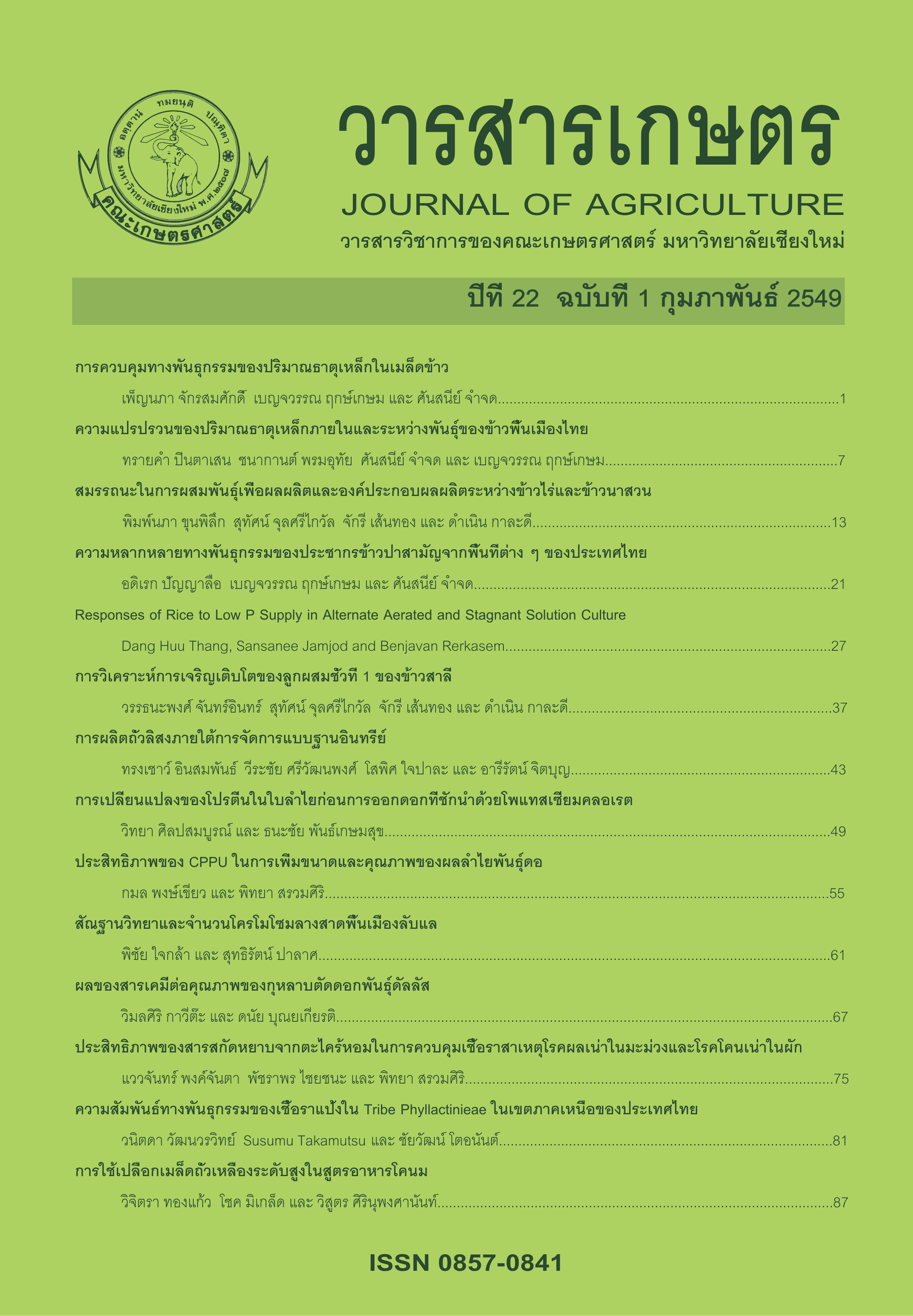Phylogenetics of the Powdery Mildews in Tribe Phyllactinieae in Northern Thailand
Main Article Content
Abstract
The morphological study of the powdery mildews in Tribe Phyllactinieae in Northern Thailand and phylogenetic relationship of this fungal group, 13 fungal specimens, were used for sequencing of a nuclear large subunit (28S) and internal transcribed spacer (ITS) of rDNA region and compared with the sequence obtained from the DNA Databank of Japan (DDBJ). The sequences were initially aligned using the Clustal X package. Phylogenetic tree was obtained from the data using maximum parsimony methods. The results indicated that 9 specimens were belonging to genus Ovulariopsis and 4 specimens were belonging to genus Oidiopsis. Moreover, from the phylogenetic tree, 9 fungi in genus Ovulariopsis can be grouped into 6 different groups. The genus Oidiopsis was classified as the same fungal group and are identified as Leveillula taurica. In addition, within 15 host plants species, 13 species were first recorded in Thailand, in which 2 of these were first recorded in the world. This was the first comprehensive study of the powdery mildews belonging to Tribe Phyllactinieae in Thailand which compared morphological characteristics and phylogenetic analyses of the ITS and 28S nucleotide sequence.
Article Details
References
Felsenstein, J. 1985. Confidence limits on phylogenies: An approach using the bootstrap. Evolution 39: 783-791.
Giatgong, P. 1980. Host Index of Plant Disease in Thailand. Mycology Branch, Plant Pathology and Microbiology Division, Department of Agriculture, Bangkok. 118 pp.
Hirata, K. 1942. On the shape of the germ tubes of Erysiphaceae. Bull. Chiba Coll. Hort. 5: 34-49.
Hirata, K. 1955. On the shape of the germ tubes of Erysiphaceae (II). Bull. Fac. Agric. Niigata Univ. 7: 24-36.
Hirata, T. and S. Takamutsu. 1996. Nucleotide sequence diversity of rDNA internal transcribed spacers extracted from conidia and cleistothecia of several powdery mildew fungi. Mycoscience 37: 283-288.
Kishino, H. and M. Hasegawa. 1989. Evaluation of the maximum likelihood estimate of the evolutionary tree topologies from DNA sequence data, and the branching order in Hominoidea. J. Mol. Evol. 29: 170-179.
Shin, H. D. 2000. Erysiphaceae of Korea. Department of Agricultural Biology, Korea University, Seoul. 320 pp.
Swofford, D. L. 2001. PAUP*:Phylogenetic Analysis Using Parsimony (and other Methods) 4.0b8. Sinauer Associates, Sunderland, MA.
Thomson, J. D., T. J. Gibson, F. Plewniak, F. Jeanmougin and D. G. Higgins, 1997. The
Clustal X windows interface: Flexible strategies for multiple sequence alignment aided by quality analysis tools. Nucleic Acids Res. 24: 4876-4882.
Walsh, P. S., D. A. Metzger and R. Higuchi. 1991. Chelex® 100 as a medium for simple extraction of DNA for PCR-based typing from forensic material. Biotechniques 10: 506-513.


